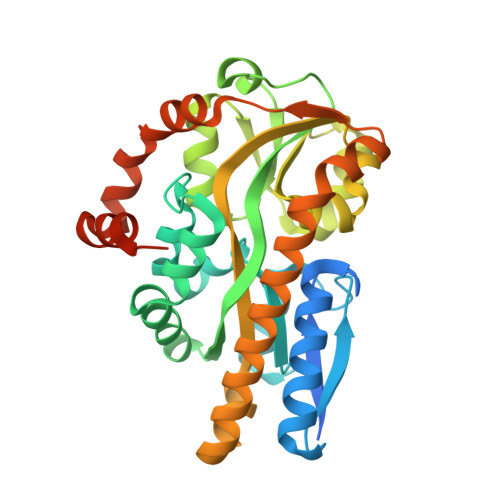Experimental strategies for functional annotation and metabolism discovery: targeted screening of solute binding proteins and unbiased panning of metabolomes.
Vetting, M.W., Al-Obaidi, N., Zhao, S., San Francisco, B., Kim, J., Wichelecki, D.J., Bouvier, J.T., Solbiati, J.O., Vu, H., Zhang, X., Rodionov, D.A., Love, J.D., Hillerich, B.S., Seidel, R.D., Quinn, R.J., Osterman, A.L., Cronan, J.E., Jacobson, M.P., Gerlt, J.A., Almo, S.C.(2015) Biochemistry 54: 909-931
- PubMed: 25540822
- DOI: https://doi.org/10.1021/bi501388y
- Primary Citation of Related Structures:
4LN5, 4MCO, 4MEV, 4MHF, 4MIJ, 4MNC, 4MNI, 4MX6, 4N15, 4N17, 4N4U, 4N6D, 4N6K, 4N8G, 4N8Y, 4N91, 4NAP, 4NF0, 4NG7, 4NGU, 4NHB, 4NN3, 4NQ8, 4NX1, 4O7M, 4O8M, 4O94, 4OA4, 4OAN, 4OVP, 4OVQ, 4OVR, 4OVS, 4OVT, 4P1E, 4P1L, 4P3L, 4P47, 4P56, 4P8B, 4P9K, 4PAF, 4PAI, 4PAK, 4PBH, 4PBQ, 4PC9, 4PCD, 4PDD, 4PDH - PubMed Abstract:
The rate at which genome sequencing data is accruing demands enhanced methods for functional annotation and metabolism discovery. Solute binding proteins (SBPs) facilitate the transport of the first reactant in a metabolic pathway, thereby constraining the regions of chemical space and the chemistries that must be considered for pathway reconstruction. We describe high-throughput protein production and differential scanning fluorimetry platforms, which enabled the screening of 158 SBPs against a 189 component library specifically tailored for this class of proteins. Like all screening efforts, this approach is limited by the practical constraints imposed by construction of the library, i.e., we can study only those metabolites that are known to exist and which can be made in sufficient quantities for experimentation. To move beyond these inherent limitations, we illustrate the promise of crystallographic- and mass spectrometric-based approaches for the unbiased use of entire metabolomes as screening libraries. Together, our approaches identified 40 new SBP ligands, generated experiment-based annotations for 2084 SBPs in 71 isofunctional clusters, and defined numerous metabolic pathways, including novel catabolic pathways for the utilization of ethanolamine as sole nitrogen source and the use of d-Ala-d-Ala as sole carbon source. These efforts begin to define an integrated strategy for realizing the full value of amassing genome sequence data.
Organizational Affiliation:
Department of Biochemistry, Albert Einstein College of Medicine , Bronx, New York 10461, United States.



















